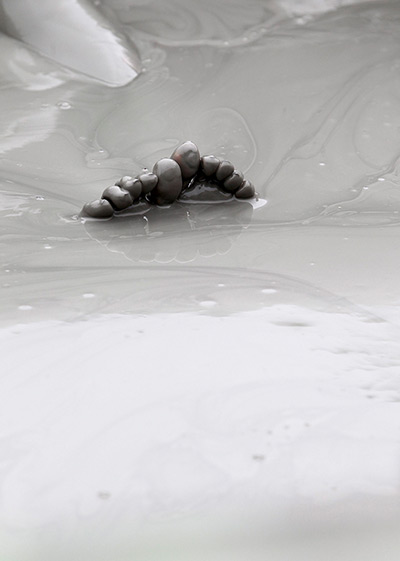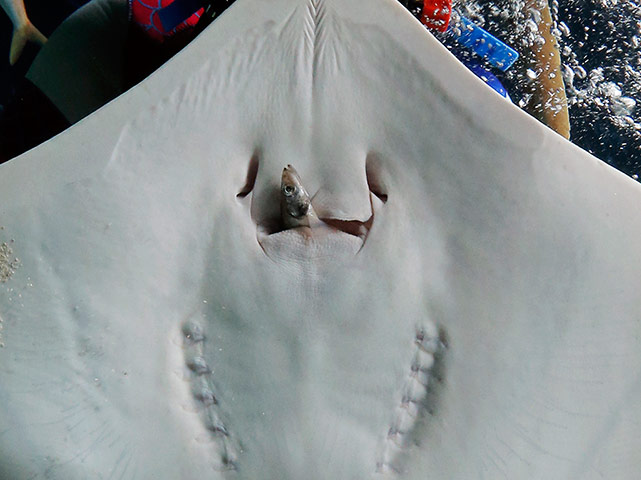It’s not easy to take a distinctive photograph at the beach. They’ve all been seen already, except perhaps for this one.
At first glance, I wondered what I was seeing. Was it some strange species from the liminal realm between earth and sea: gooey, nearly featureless, and dumb, but able to survive for millions of years as something almost as much plant as animal? On closer inspection, the correct species definition locked into place: toes, paired feet, human being (as Aristotle put it so aptly, a featherless biped). And only later did I also notice the legs emerging from the sandy ooze in the background. One fragment now was two having some figural continuity (although the line was still partially obscured), and it became easier to imagine not just the rest of the body but the person, someone not buried but rather soaking in the cool waters pooling along the shore, enjoying a day at the beach.
Now maybe you got that right away. My obtuseness may be the problem. Whether due to the fact that my beach time has been rather limited, lifetime, or that I’m easily smitten by surface effects such as the sheen of the watery sand, it may have been too easy for me to not see the obvious. But if you weren’t mistaken, try to see it as if you didn’t know. Look at that image as if it could be documenting another species, or as if it were a work of art where what mattered most was the way the smaller, darker, firmer shape emerged out of the lighter, liquid substance suffusing the visual field.
This figure-ground inversion may not be possible: as in the classic drawing, when you see the two heads in profile, you can’t see the vase. But what you can do, I hope, is look again at the photo and see how the photographer’s adroit use of figure-ground composition has created an opportunity to see the human species as something a bit strange–as if it were not the “rational animal” but rather defined primarily by its ability to stay out of the primordial ooze by blind adaptation for sheer biological continuity.
Humans don’t often define their species by its feet, which are not seen as the basis for an exalted view of ourselves–but here they look almost sentient, if barely so. Perhaps we should spend more time pondering them, and not just as one way to idle away the time on vacation. And one might ask how odd the human body could appear when seen only as, say, an elbow, ear, or back. And how is self-consciousness itself a protrusion amidst a bodily, behavioral field that is itself arbitrarily defined? Which leads to another photo from the summer slide shows.
Again, the composition features a strong contrast between figure and ground. The small fish protrudes out of the much larger body of the ray, which encompasses most of the visual field. Like the liquid sand, the ray’s body is a subtly modulated light surface carrying the power of nature. There also are significant differences, however. The figure of the fish is the more familiar sight than the closely cropped ray’s body, and the portion of the fish that is not seen is evidence of disintegration, not wholeness. The fish is going into the maw, not peeking out, and if it is sentient–one can imagine a last shock of biological awareness that life is ending–that is about to end. Consciousness, like any life form, can emerge, and it can be swallowed up again. The photograph brings one to consider how the most ordinary of processes–animal eating animal–is also strange, violent, awful perhaps, while also being completely routine, natural, like gliding through the water and breathing. The smooth, uniform body of the ray covers the digestive processes, just as the smooth, liquid surface of the shoreline covers the struggle for life that leads each species to find its niche or die.
Human beings are the strangest animals in that they have survived without yet finding their niche. One might think of that as a figure-ground problem. In any case, artworks such as those above provide one basis for rethinking self-awareness against the background of nature.
Photographs by Jeon Heon-kyun/European Pressphoto Agency and Itsuo Inouye/Associated Press.


I had a similar visual puzzlement with this photograph by Man Ray:
http://vi.sualize.us/b68dc857ad5b020a73_600_774_pixels_body_bw_photo_man_picture_3bTX.html
I could tell immediately that it was a live creature, but it took a bit longer to see that it was indeed a human being.